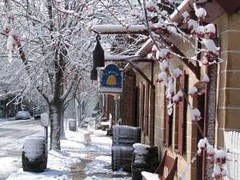Is the greenest neighborhood the one that is already built?

Posted March 4, 2009 at 1:24PM
As I alluded last week, it has become trendy in preservation circles to say that "the greenest building is one that is already built." The catchy phrase is usually attributed to Carl Elifante, who said as much in the National Trust's journal two years ago.
Now that's not always literally true, especially if the building is, say, in the middle of an office park somewhere 30 miles from a region's center. Nor is it true if the building is in a very cold or very warm climate and lacks decent insulation.  But the phrase is still very useful rhetorically, because there is a lot of truth to it, especially if the building was designed for the ages, which, after all, used to be the case more often than not.
But the phrase is still very useful rhetorically, because there is a lot of truth to it, especially if the building was designed for the ages, which, after all, used to be the case more often than not.
But does it apply to neighborhoods as well? I think the answer is pretty similar. Older neighborhoods from the pre-sprawl era generally function very well environmentally. They tend to be well-located and designed for walkability; they tend to use land in an orderly and efficient way. The newer ones? Well, you already know how some of those perform.
Which brings me to Barbara Campagna's new True Green blog posts on the National Trust's blog site. Barbara is one of the leaders of the Trust's sustainability program, and she is also a very good and thoughtful writer. She has a terrific new post up on the historic neighborhood of Old Salem, in North Carolina, and how well it serves as a model of the characteristics we seek in well-functioning, green communities. Apparently, a rare North Carolina snowstorm led to a walk, which led to thoughts, which led to writing:
"As I walked around I thought a lot about what makes a walkable neighborhood, why the New Urbanists keep trying to copy historic places and call them "new", and why our historic sites (at the National Trust, at Old Salem and all over the country) offer so many lessons if we just slow down a bit.
"And so why is a place like Old Salem inherently green and worthy of discussion in my "True Green" blog? Because all around me I find the innate green technologies that the green techies and architects among us keep trying to replicate - tall operable windows with shutters, front porches with big overhangs, narrow streets, more gardens than non-permeable roads and parking lots, and a green town "square". But what makes it more special to my thinking, more special than say a totally fabricated new development is that it grew up over a couple of centuries . . ."
As you can see, Barbara also took some terrific photos. Go here for the entire post.